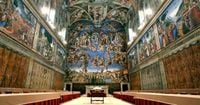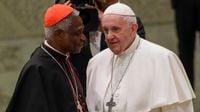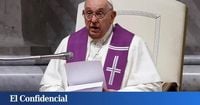The death of Pope Francis on April 21, 2025, has ignited intense speculation about who will succeed him as the leader of over 1.3 billion Catholics worldwide. With his passing, the papal conclave is set to convene in the Sistine Chapel to determine the future direction of the Catholic Church, a process steeped in tradition and secrecy. An old saying in the Vatican reminds us, "You enter a conclave as pope, you leave as cardinal," emphasizing the unpredictable nature of this sacred election.
Since 1378, only cardinals have been eligible for the papacy, and the new pope must secure at least two-thirds of the votes from cardinals under 80 years old. Jorge Mario Bergoglio, known as Pope Francis, was once considered too old at 76 to be elected in 2013, and Karol Wojtyla (Pope John Paul II) was not a favorite in his own conclave in 1978. This history illustrates the often surprising outcomes of papal elections.
Among the potential candidates, several names stand out. Cardinal Peter Erdö, born in Hungary on June 25, 1952, has served as the archbishop of Budapest and has been elected twice as head of the Council of European Episcopal Conferences. His connections with both European and African cardinals make him a strong contender, although his conservative views on issues like marriage and LGBTQ+ rights might alienate some progressive voters.
Cardinal Reinhard Marx, born in Germany on September 21, 1953, has been a key advisor to Pope Francis since 2013. He led the German Church's controversial "synodal path" in response to the clergy sex abuse scandal, advocating for dialogue on sensitive issues. However, his progressive stance has raised skepticism among conservative factions within the Church.
Another significant figure is Cardinal Marc Ouellet, born in Canada on June 8, 1944. He has overseen the Vatican's office of bishops for over a decade and has been involved in investigating bishops accused of covering up abuse. Although he is seen as more conservative than Francis, he has also called for greater roles for women in Church governance.
Cardinal Pietro Parolin, born in Italy on January 17, 1955, has served as Secretary of State since 2014. Known for his diplomatic skills, he has been involved in significant agreements, such as the controversial deal with China regarding bishop appointments. Parolin is viewed as a stabilizing candidate who could bridge the gap between progressive and conservative factions.
Cardinal Robert Sarah, born in Guinea on January 15, 1945, represents a more traditional viewpoint and has been a vocal critic of some of Pope Francis's reforms. He has garnered respect for his strong stances on Church doctrine, but his hardline views may face resistance from those seeking a more progressive papacy.
Cardinal Christoph Schönborn, born in Austria on January 22, 1945, has been an influential figure in the Church, known for his academic background and close ties to Pope Benedict XVI. His support for Francis's approach to divorced and remarried Catholics has drawn both admiration and criticism.
On the more progressive side, Cardinal Luis Tagle from the Philippines, born on June 21, 1957, is often referred to as the "Asian Francis" due to his commitment to social justice and inclusivity. His charismatic personality and extensive pastoral experience make him a popular candidate, though his relative youth could be seen as a disadvantage.
Cardinal Matteo Zuppi, born in Italy on October 11, 1955, is closely associated with the Sant'Egidio Community and has been active in interreligious dialogue. His progressive views and focus on marginalized communities align closely with Francis's vision, positioning him as a strong candidate for those advocating continuity.
As the conclave prepares to convene, the question remains: will the cardinals opt for continuity with Francis's progressive agenda or choose a candidate who may steer the Church in a more traditional direction? The conclave's dynamics are complex, influenced by personal relationships, theological perspectives, and the pressing issues facing the global Church.
The election process itself is a blend of solemnity and secrecy. Following the death of a pope, a period known as "sede vacante" begins, during which the cardinals gather to elect a new pope. The first vote occurs in the Sistine Chapel the afternoon after the initial mass, with subsequent votes held twice daily until a consensus is reached. If no pope is elected, black smoke will rise from the chimney, signaling the ongoing deliberations, while white smoke will announce the election of a new pope.
Once elected, the new pope will be presented to the world from the loggia overlooking St. Peter's Square, where the traditional proclamation of "Habemus Papam!" (We have a pope!) will be made. This moment will mark the beginning of a new era for the Catholic Church, as the chosen leader sets the course for the future.
With the world watching closely, the conclave will not only determine the next pope but also reflect the evolving landscape of the Catholic Church in a modern world. The candidates represent a spectrum of theological and pastoral approaches, and their election will signal the direction the Church intends to take in addressing contemporary issues.
As the cardinals prepare to cast their votes, the anticipation builds. Who will emerge as the next leader of the Catholic Church? The answer lies in the hands of the conclave, and the world waits for the smoke signals from the Vatican.





